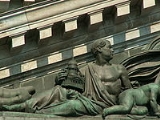
Auguste de Montferrand
Encyclopedia
Auguste de Montferrand was a French Neoclassical
architect
who worked primarily in Russia
. His two best known works are the Saint Isaac's Cathedral
and the Alexander Column
in St. Petersburg.
, France
(now the 16th arrondissement of Paris). He was styled at birth
Henri Louis Auguste Leger Ricard dit de Montferrand; the aristocratic de was probably his parents' invention. Decades later, Montferrand admitted in his will that, although his father owned Montferrand estate, the title is disputable "and if there is any doubt, I can accept other names, first of all Ricard, after my father". Montferrand's father, Benois Ricard, was a horse trainer who died when Montferrand was a child; his grandfather, Leger Ricard, was a bridge engineer. Montferrand's mother, Marie Francoise Louise Fistioni, remarried to Antoine de Commarieux, who is credited with educating Montferrand.
, joining class of Charles Percier
and Pierre Fontaine
. Soon, he was summoned to Napoleon's Army, and served a brief tour of duty in Italy
.
Montferrand married Julia Mornais in 1812. The next year, he was again drafted into the Army when Allied troops were approaching Dresden
. Montferrand served with distinction in Thuringia
, and was awarded the Légion d'honneur
for valor in the Battle of Hanau
.
, and presented the Tsar
with an album of his works.
In the summer of 1816, Montferrand landed in St. Petersburg, carrying a recommendation letter from Abraham-Louis Breguet. He rented a room near the house of Fyodor Wigel, the secretary of the Construction Commission, and applied to Agustín de Betancourt
, the chairman of the commission (and a partner of Breguet's in the 1790s). Betancourt, impressed by Breguet's letter and Montferrand's drawings, offered Montferrand the desk of Head of Draftsmen, but Montferrand preferred the lower rank of senior draftsman. On December 21, 1816, he officially joined the Russian service.
, Odessa
, and Nizhny Novgorod
. His first major project, the Odessa Lycaeum, did not materialize due to financing problems. His designs for the Moscow Manege
(1825) and Moscow fountains (1823) were also abandoned; these projects were completed by Joseph Bové
and Ivan Vitali
.
_cathedral.jpg) In 1816, an accidental fire destroyed the Makaryev Fair. The fairgrounds were transferred to Nizhny Novgorod
In 1816, an accidental fire destroyed the Makaryev Fair. The fairgrounds were transferred to Nizhny Novgorod
, equipped with temporary wooden trade rows. Betancourt visited the site in 1817 and proposed a six-million-rouble, four-year project to rebuild the Fair using stone. Alexander I approved it, at the expense of halting the reconstruction of the Winter Palace
Montferrand, as chief architect, reported to Betancourt, who personally managed the project. Montferrand started with the two-story main administration building. This traditional, neoclassical design was marked by custom column capitals
with a caduceus
motif. The fair itself consisted of eight two-story corner blocks and 48 standard trade row buildings.See plan of the fairground. The fairground terminated in a row of four "Chinese" pavilions, each with pagoda
roofs; the neoclassical Saviour's Cathedral, and was encircled with a wide "Betancourt's Canal"—a precaution against fire.
Despite shortages in manpower and material, the Fair opened in July 1822. Rectification work proceeded to 1825 and consumed a further 3.5 million roubles. The Fair operated until 1930; most of its buildings were torn down during the Soviet era, but the Saviour's Cathedral survives.
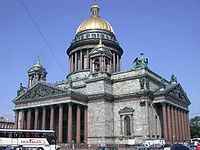
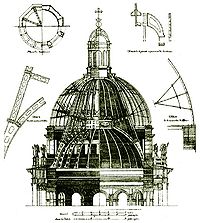 The previous St. Isaac's, laid down by Antonio Rinaldi in 1768, was partially completed in 1802 by Vincenzo Brenna
The previous St. Isaac's, laid down by Antonio Rinaldi in 1768, was partially completed in 1802 by Vincenzo Brenna
. In 1816, Alexander I assigned Betancourt to find the architect who could rebuild the cathedral; Betancourt pointed at Montferrand. Four original concepts, using as much of the old structure as possible, failed; the fifth was approved in February 1818. Rivalry between court architects temporarily halted the project between 1821 and 1825.
Montferrand's first decision was to use a slab foundation
, rather than a perimeter of piles
. The foundation work took five years. It took more than a decade to obtain the 48 granite columns for the main portico
. Columns were roughly cut in Fredrikshamn
, delivered by barge, and finished on site one by one, using a gigantic lathe
of Montferrand's own design. The columns were raised in 1828–1830; polishing took four more years. In the same time, bricklayers completed the main walls and vaulted ceilings.
Montferrand was nearly killed in November 1837, when the crews were lifting 64-ton dome columns to their full 168 feet (51.2 m) height.24 sazhen = 168 ft. Montferrand fell from the scaffolds, but nearby workers managed to catch him.
The design of St. Isaac's domes was novel. Prior to St. Isaac's, steel-frame exterior domes were coupled to masonry internal domes. Montferrand proposed an all-metal triple-dome system, where the middle conical dome carried the lightweight interior and exterior frames. This reduced dome weight from an estimated 7440 tonnes (1,171,599.5 st) to 2680 tonnes (422,027.8 st);1838 design. a further 600 tonnes (94,483.8 st) was saved in the construction process. The dome, completed in 1841, cost two million roubles less than originally estimated.
Decorating the cathedral's interior took another 16 years. Montferrand managed artists such as Karl Briullov
and his brothers, Peter Clodt
, and Ivan Vitali
, all under close inspection by the State and Academy bureaucracies. The cathedral opened on May 30, 1858—the 186th anniversary of Peter the Great's birth.
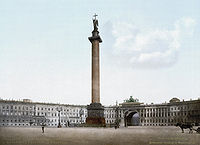
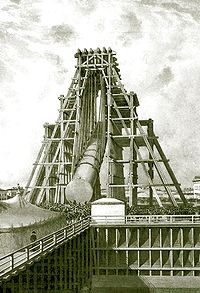 Montferrand designed the monument to the late Alexander I as a column, crowned with a cross; later, he changed the cross to an angel. The cost was estimated at 1.2 million roubles. The 600 tonnes (94,483.8 st) column had to be carved out of Finnish rocks in Fredrikshamn
Montferrand designed the monument to the late Alexander I as a column, crowned with a cross; later, he changed the cross to an angel. The cost was estimated at 1.2 million roubles. The 600 tonnes (94,483.8 st) column had to be carved out of Finnish rocks in Fredrikshamn
, more than 100 nautical miles (185.2 km) from St. Petersburg, and transported by barge. Critics predicted that the column would fall apart upon separation from the rock, but Montferrand's experience with the columns of St. Isaac's persuaded Nicholas I
, who approved the project in December 1829.
Montferrand selected the quarry contractor in March 1830, in a bidding war that reduced the column price from 420 thousand to 150 thousand roubles. Carving took a year and a half, and in September 1831 the column safely separated from the rock. By April 1832, the carvers completed shaping it and started blasting the path from the quarry to the loading bay. The barge loading nearly ended in a catastrophe. The column broke through the ramp and threatened to roll over the barge; a team of 300 workers managed to set it back in place.
At the same time, crews in St. Petersburg prepared the foundation and scaffolding; the cost estimate doubled to 2.36 million roubles. Montferrand summoned a total of 2,090 soldiers, officers, and professionals to erect the column, raising it safely on August 30, 1832. Precisely two years later, the monument was inaugurated by Nicholas.One year was lost for academic debate about the angel's statue; finally, Nicholas I intervened and decreed that the single angel must be six arshin (14 feet or 4.3 m) tall.
In 1836–1837, Montferrand completed the Palace Square with fencing and gas lights. He prepared five different designs for the building terminating the eastern side of the square, but the Guards Corps building was awarded to Alexander Brullov
.
with temporary fittings. By 1827, the plaster sculptures were falling apart, and a leaking roof threatened to destroy frescoes and floors. Nicholas assigned Montferrand to fix the roof, replace floors, and install permanent, durable sculptures and finishes. Montferrand also supervised new fresco paintings (The Four Evangelists
). He lost the bid to design the new iconostasis
to young Konstantin Thon
.
Montferrand, as the Cathedral's architect, landscaped the adjacent square and designed the monuments to Kutuzov
and Barclay de Tolly
. The statues were made by Boris Orlovsky
, and the bases by Vasily Stasov.
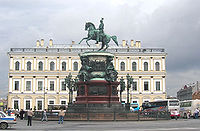 The Monument to Nicholas I
The Monument to Nicholas I
was Montferrand's last work, commissioned by Alexander II
in May 1856. The foundation and base was started with leftovers from the St. Isaac's site.
The contract for the equestrian statue was awarded to Peter Clodt
. Clodt completed the model in the summer of 1857. The first bronze cast was lost when the mold
cracked; a second statue was cast in February 1859—after Montferrand's death.
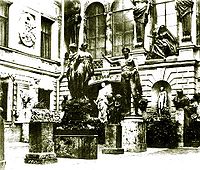 Monferrand divorced his first wife soon after settling in St. Petersburg. The divorce, and his extravagant lifestyle, caused him a lot of debts; in 1831, he refinanced his debt with a loan from the Tsar's Cabinet. In 1834, he was awarded a lifelong pension and a 100,000-rouble lump sum, enabling him to settle his accounts and build his own house. As his finances improved, Montferrand became a compulsive art collector, amassing 110 Greek and Roman statues and hundreds of lesser items. Witnesses reported that "any Sunday he indulged in rearranging the statues, using 25 laborers from 9 a.m. to lunch time". When Monferrand died, the Hermitage Museum
Monferrand divorced his first wife soon after settling in St. Petersburg. The divorce, and his extravagant lifestyle, caused him a lot of debts; in 1831, he refinanced his debt with a loan from the Tsar's Cabinet. In 1834, he was awarded a lifelong pension and a 100,000-rouble lump sum, enabling him to settle his accounts and build his own house. As his finances improved, Montferrand became a compulsive art collector, amassing 110 Greek and Roman statues and hundreds of lesser items. Witnesses reported that "any Sunday he indulged in rearranging the statues, using 25 laborers from 9 a.m. to lunch time". When Monferrand died, the Hermitage Museum
failed to buy out the collection, and it was dispersed.
faith. His body was returned to France and buried in the Cimetière de Montmartre, Paris, next to his mother. The grave, once believed to be lost, was identified in 1986 in Chemin des Gardes row. It bears the name Louise Fistioni (Montferrand's mother) and "AM", Montferrand's initials.
Neoclassical architecture
Neoclassical architecture was an architectural style produced by the neoclassical movement that began in the mid-18th century, manifested both in its details as a reaction against the Rococo style of naturalistic ornament, and in its architectural formulas as an outgrowth of some classicizing...
architect
Architect
An architect is a person trained in the planning, design and oversight of the construction of buildings. To practice architecture means to offer or render services in connection with the design and construction of a building, or group of buildings and the space within the site surrounding the...
who worked primarily in Russia
Russia
Russia or , officially known as both Russia and the Russian Federation , is a country in northern Eurasia. It is a federal semi-presidential republic, comprising 83 federal subjects...
. His two best known works are the Saint Isaac's Cathedral
Saint Isaac's Cathedral
Saint Isaac's Cathedral or Isaakievskiy Sobor in Saint Petersburg, Russia is the largest Russian Orthodox cathedral in the city...
and the Alexander Column
Alexander Column
The Alexander Column also known as Alexandrian Column , is the focal point of Palace Square in Saint Petersburg, Russia. The monument was erected after the Russian victory in the war with Napoleon's France...
in St. Petersburg.
Family
Montferrand was born in the parish of ChaillotTrocadéro
The Trocadéro, , site of the Palais de Chaillot, , is an area of Paris, France, in the 16th arrondissement, across the Seine from the Eiffel Tower. The hill of the Trocadéro is the hill of Chaillot, a former village.- Origin of the name :...
, France
France
The French Republic , The French Republic , The French Republic , (commonly known as France , is a unitary semi-presidential republic in Western Europe with several overseas territories and islands located on other continents and in the Indian, Pacific, and Atlantic oceans. Metropolitan France...
(now the 16th arrondissement of Paris). He was styled at birth
Henri Louis Auguste Leger Ricard dit de Montferrand; the aristocratic de was probably his parents' invention. Decades later, Montferrand admitted in his will that, although his father owned Montferrand estate, the title is disputable "and if there is any doubt, I can accept other names, first of all Ricard, after my father". Montferrand's father, Benois Ricard, was a horse trainer who died when Montferrand was a child; his grandfather, Leger Ricard, was a bridge engineer. Montferrand's mother, Marie Francoise Louise Fistioni, remarried to Antoine de Commarieux, who is credited with educating Montferrand.
Education and War
In 1806, Montferrand joined the former Académie d'architectureAcadémie d'architecture
The Académie royale d'architecture was a French learned society founded on December 30, 1671 by Louis XIV, king of France under the impulsion of Jean-Baptiste Colbert...
, joining class of Charles Percier
Charles Percier
Charles Percier was a neoclassical French architect, interior decorator and designer, who worked in a close partnership with Pierre François Léonard Fontaine, originally his friend from student days...
and Pierre Fontaine
Pierre François Léonard Fontaine
Pierre François Léonard Fontaine was a neoclassical French architect, interior decorator and designer.Starting from 1794 Fontaine worked in such close partnership with Charles Percier, originally his friend from student days, that it is difficult to distinguish their work...
. Soon, he was summoned to Napoleon's Army, and served a brief tour of duty in Italy
Italy
Italy , officially the Italian Republic languages]] under the European Charter for Regional or Minority Languages. In each of these, Italy's official name is as follows:;;;;;;;;), is a unitary parliamentary republic in South-Central Europe. To the north it borders France, Switzerland, Austria and...
.
Montferrand married Julia Mornais in 1812. The next year, he was again drafted into the Army when Allied troops were approaching Dresden
Battle of Dresden
The Battle of Dresden was fought on 26–27 August 1813 around Dresden, Germany, resulting in a French victory under Napoleon I against forces of the Sixth Coalition of Austrians, Russians and Prussians under Field Marshal Schwartzenberg. However, Napoleon's victory was not as complete as it could...
. Montferrand served with distinction in Thuringia
Thuringia
The Free State of Thuringia is a state of Germany, located in the central part of the country.It has an area of and 2.29 million inhabitants, making it the sixth smallest by area and the fifth smallest by population of Germany's sixteen states....
, and was awarded the Légion d'honneur
Légion d'honneur
The Legion of Honour, or in full the National Order of the Legion of Honour is a French order established by Napoleon Bonaparte, First Consul of the Consulat which succeeded to the First Republic, on 19 May 1802...
for valor in the Battle of Hanau
Battle of Hanau
The Battle of Hanau was fought on between Karl Philipp von Wrede’s Austro-Bavarian corps and Napoleon's retreating French during the War of the Sixth Coalition....
.
Career begins
When hostilities ended, new construction in defeated France was out of the question. Montferrand worked on a few unimportant jobs, spending three years performing basic draftsmanship and seeking opportunities overseas. In 1815, he was granted an audience with Alexander I of RussiaAlexander I of Russia
Alexander I of Russia , served as Emperor of Russia from 23 March 1801 to 1 December 1825 and the first Russian King of Poland from 1815 to 1825. He was also the first Russian Grand Duke of Finland and Lithuania....
, and presented the Tsar
Tsar
Tsar is a title used to designate certain European Slavic monarchs or supreme rulers. As a system of government in the Tsardom of Russia and Russian Empire, it is known as Tsarist autocracy, or Tsarism...
with an album of his works.
In the summer of 1816, Montferrand landed in St. Petersburg, carrying a recommendation letter from Abraham-Louis Breguet. He rented a room near the house of Fyodor Wigel, the secretary of the Construction Commission, and applied to Agustín de Betancourt
Agustín de Betancourt
Agustín de Betancourt y Molina was a prominent Spanish-Canarian engineer, who worked in Spain, France and Russia. His work ranged from steam engines and balloons to structural engineering and urban planning...
, the chairman of the commission (and a partner of Breguet's in the 1790s). Betancourt, impressed by Breguet's letter and Montferrand's drawings, offered Montferrand the desk of Head of Draftsmen, but Montferrand preferred the lower rank of senior draftsman. On December 21, 1816, he officially joined the Russian service.
Buildings
Montferrand's name is associated with St. Petersburg. However, working with Betancourt, he also designed buildings in MoscowMoscow
Moscow is the capital, the most populous city, and the most populous federal subject of Russia. The city is a major political, economic, cultural, scientific, religious, financial, educational, and transportation centre of Russia and the continent...
, Odessa
Odessa
Odessa or Odesa is the administrative center of the Odessa Oblast located in southern Ukraine. The city is a major seaport located on the northwest shore of the Black Sea and the fourth largest city in Ukraine with a population of 1,029,000 .The predecessor of Odessa, a small Tatar settlement,...
, and Nizhny Novgorod
Nizhny Novgorod
Nizhny Novgorod , colloquially shortened to Nizhny, is, with the population of 1,250,615, the fifth largest city in Russia, ranking after Moscow, St. Petersburg, Novosibirsk, and Yekaterinburg...
. His first major project, the Odessa Lycaeum, did not materialize due to financing problems. His designs for the Moscow Manege
Moscow Manege
Moscow Manege is a large oblong building which gives its name to the vast Manege Square, which was cleared in the 1930s, adjacent to the more famous Red Square...
(1825) and Moscow fountains (1823) were also abandoned; these projects were completed by Joseph Bové
Joseph Bové
Joseph Bové was a Russian neoclassical architect with Italian roots who supervised reconstruction of Moscow after the Fire of 1812.-Biography:...
and Ivan Vitali
Ivan Vitali
Ivan Petrovich Vitali was a Russian sculptor of Italian descent. Born in Saint Petersburg, he was apprenticed to his father, Pietro Vitali, from an early age. After attending the Imperial Academy of Arts he moved to Moscow in 1818...
.
Nizhny Novgorod Fair (1817–1825)
_cathedral.jpg)
Nizhny Novgorod
Nizhny Novgorod , colloquially shortened to Nizhny, is, with the population of 1,250,615, the fifth largest city in Russia, ranking after Moscow, St. Petersburg, Novosibirsk, and Yekaterinburg...
, equipped with temporary wooden trade rows. Betancourt visited the site in 1817 and proposed a six-million-rouble, four-year project to rebuild the Fair using stone. Alexander I approved it, at the expense of halting the reconstruction of the Winter Palace
Winter Palace
The Winter Palace in Saint Petersburg, Russia, was, from 1732 to 1917, the official residence of the Russian monarchs. Situated between the Palace Embankment and the Palace Square, adjacent to the site of Peter the Great's original Winter Palace, the present and fourth Winter Palace was built and...
Montferrand, as chief architect, reported to Betancourt, who personally managed the project. Montferrand started with the two-story main administration building. This traditional, neoclassical design was marked by custom column capitals
Capital (architecture)
In architecture the capital forms the topmost member of a column . It mediates between the column and the load thrusting down upon it, broadening the area of the column's supporting surface...
with a caduceus
Caduceus
The caduceus is the staff carried by Hermes in Greek mythology. The same staff was also borne by heralds in general, for example by Iris, the messenger of Hera. It is a short staff entwined by two serpents, sometimes surmounted by wings...
motif. The fair itself consisted of eight two-story corner blocks and 48 standard trade row buildings.See plan of the fairground. The fairground terminated in a row of four "Chinese" pavilions, each with pagoda
Pagoda
A pagoda is the general term in the English language for a tiered tower with multiple eaves common in Nepal, India, China, Japan, Korea, Vietnam and other parts of Asia. Some pagodas are used as Taoist houses of worship. Most pagodas were built to have a religious function, most commonly Buddhist,...
roofs; the neoclassical Saviour's Cathedral, and was encircled with a wide "Betancourt's Canal"—a precaution against fire.
Despite shortages in manpower and material, the Fair opened in July 1822. Rectification work proceeded to 1825 and consumed a further 3.5 million roubles. The Fair operated until 1930; most of its buildings were torn down during the Soviet era, but the Saviour's Cathedral survives.
St. Isaac's Cathedral (1816–1858)


Vincenzo Brenna
Vincenzo Brenna was an Italian architect and painter who was the house architect of Paul I of Russia. Brenna was hired by Paul and his spouse Maria Fyodorovna as interior decorator in 1781 and by the end of 1780s became the couple's leading architect...
. In 1816, Alexander I assigned Betancourt to find the architect who could rebuild the cathedral; Betancourt pointed at Montferrand. Four original concepts, using as much of the old structure as possible, failed; the fifth was approved in February 1818. Rivalry between court architects temporarily halted the project between 1821 and 1825.
Montferrand's first decision was to use a slab foundation
Shallow foundation
A shallow foundation is a type of foundation which transfers building loads to the earth very near the surface, rather than to a subsurface layer or a range of depths as does a deep foundation...
, rather than a perimeter of piles
Deep foundation
A deep foundation is a type of foundation distinguished from shallow foundations by the depth they are embedded into the ground. There are many reasons a geotechnical engineer would recommend a deep foundation over a shallow foundation, but some of the common reasons are very large design loads, a...
. The foundation work took five years. It took more than a decade to obtain the 48 granite columns for the main portico
Portico
A portico is a porch leading to the entrance of a building, or extended as a colonnade, with a roof structure over a walkway, supported by columns or enclosed by walls...
. Columns were roughly cut in Fredrikshamn
Hamina
Hamina is a town and a municipality of Finland. It is located in the province of Southern Finland and is part of the Kymenlaakso region. The town has a population of and covers an area of ofwhich is water. The population density is...
, delivered by barge, and finished on site one by one, using a gigantic lathe
Lathe
A lathe is a machine tool which rotates the workpiece on its axis to perform various operations such as cutting, sanding, knurling, drilling, or deformation with tools that are applied to the workpiece to create an object which has symmetry about an axis of rotation.Lathes are used in woodturning,...
of Montferrand's own design. The columns were raised in 1828–1830; polishing took four more years. In the same time, bricklayers completed the main walls and vaulted ceilings.
Montferrand was nearly killed in November 1837, when the crews were lifting 64-ton dome columns to their full 168 feet (51.2 m) height.24 sazhen = 168 ft. Montferrand fell from the scaffolds, but nearby workers managed to catch him.
The design of St. Isaac's domes was novel. Prior to St. Isaac's, steel-frame exterior domes were coupled to masonry internal domes. Montferrand proposed an all-metal triple-dome system, where the middle conical dome carried the lightweight interior and exterior frames. This reduced dome weight from an estimated 7440 tonnes (1,171,599.5 st) to 2680 tonnes (422,027.8 st);1838 design. a further 600 tonnes (94,483.8 st) was saved in the construction process. The dome, completed in 1841, cost two million roubles less than originally estimated.
Decorating the cathedral's interior took another 16 years. Montferrand managed artists such as Karl Briullov
Karl Briullov
Karl Pavlovich Bryullov , also transliterated Briullov or Briuloff and referred to by his friends as "The Great Karl", was a Russian painter...
and his brothers, Peter Clodt
Peter Clodt von Jürgensburg
Baron Peter Clodt von Jürgensburg, known in Russian as Pyotr Karlovich Klodt , was a favourite sculptor of Nicholas I of Russia.Stemming from a distinguished family of Baltic Germans, Clodt von Jürgensburg, Klodt started his career as a professional artillery officer and amateur sculptor...
, and Ivan Vitali
Ivan Vitali
Ivan Petrovich Vitali was a Russian sculptor of Italian descent. Born in Saint Petersburg, he was apprenticed to his father, Pietro Vitali, from an early age. After attending the Imperial Academy of Arts he moved to Moscow in 1818...
, all under close inspection by the State and Academy bureaucracies. The cathedral opened on May 30, 1858—the 186th anniversary of Peter the Great's birth.
Alexander's Column (1829–1834)


Hamina
Hamina is a town and a municipality of Finland. It is located in the province of Southern Finland and is part of the Kymenlaakso region. The town has a population of and covers an area of ofwhich is water. The population density is...
, more than 100 nautical miles (185.2 km) from St. Petersburg, and transported by barge. Critics predicted that the column would fall apart upon separation from the rock, but Montferrand's experience with the columns of St. Isaac's persuaded Nicholas I
Nicholas I of Russia
Nicholas I , was the Emperor of Russia from 1825 until 1855, known as one of the most reactionary of the Russian monarchs. On the eve of his death, the Russian Empire reached its historical zenith spanning over 20 million square kilometers...
, who approved the project in December 1829.
Montferrand selected the quarry contractor in March 1830, in a bidding war that reduced the column price from 420 thousand to 150 thousand roubles. Carving took a year and a half, and in September 1831 the column safely separated from the rock. By April 1832, the carvers completed shaping it and started blasting the path from the quarry to the loading bay. The barge loading nearly ended in a catastrophe. The column broke through the ramp and threatened to roll over the barge; a team of 300 workers managed to set it back in place.
At the same time, crews in St. Petersburg prepared the foundation and scaffolding; the cost estimate doubled to 2.36 million roubles. Montferrand summoned a total of 2,090 soldiers, officers, and professionals to erect the column, raising it safely on August 30, 1832. Precisely two years later, the monument was inaugurated by Nicholas.One year was lost for academic debate about the angel's statue; finally, Nicholas I intervened and decreed that the single angel must be six arshin (14 feet or 4.3 m) tall.
In 1836–1837, Montferrand completed the Palace Square with fencing and gas lights. He prepared five different designs for the building terminating the eastern side of the square, but the Guards Corps building was awarded to Alexander Brullov
Alexander Brullov
Alexander Pavlovich Brullov was a Russian artist associated with the latest phase of the Russian Neoclassicism.Alexander Brullov was born in Saint Petersburg into a family of French artists: his great grandfather, his grandfather, his father and his brothers were artists. His first teacher was...
.
Completion of Kazansky Cathedral and Square (1827–1837)
As the chief architect of St. Petersburg's largest construction site, Montferrand supervised many other architectural jobs for the State, notably repairs of Kazan Cathedral. The Cathedral was built in 1801–1811 by Andrey VoronikhinAndrey Voronikhin
Andrey Nikiforovich Voronikhin was a Russian architect and painter. As a representative of classicism he was also one of the founders of the monumental Russian Empire style...
with temporary fittings. By 1827, the plaster sculptures were falling apart, and a leaking roof threatened to destroy frescoes and floors. Nicholas assigned Montferrand to fix the roof, replace floors, and install permanent, durable sculptures and finishes. Montferrand also supervised new fresco paintings (The Four Evangelists
Four Evangelists
In Christian tradition the Four Evangelists are Matthew, Mark, Luke, and John, the authors attributed with the creation of the four Gospel accounts in the New Testament that bear the following titles:*Gospel according to Matthew*Gospel according to Mark...
). He lost the bid to design the new iconostasis
Iconostasis
In Eastern Christianity an iconostasis is a wall of icons and religious paintings, separating the nave from the sanctuary in a church. Iconostasis also refers to a portable icon stand that can be placed anywhere within a church...
to young Konstantin Thon
Konstantin Thon
Konstantin Andreyevich Thon, also spelled Ton was an official architect of Imperial Russia during the reign of Nicholas I. His major works include the Cathedral of Christ the Saviour, the Grand Kremlin Palace and the Kremlin Armoury in Moscow....
.
Montferrand, as the Cathedral's architect, landscaped the adjacent square and designed the monuments to Kutuzov
Mikhail Illarionovich Kutuzov
Mikhail Illarionovich Golenishchev-Kutuzov was a Field Marshal of the Russian Empire. He served as one of the finest military officers and diplomats of Russia under the reign of three Romanov Tsars: Catherine II, Paul I and Alexander I...
and Barclay de Tolly
Michael Andreas Barclay de Tolly
Prince Michael Andreas Barclay de Tolly , was a Russian Field Marshal and Minister of War during Napoleon's invasion in 1812 and War of the Sixth Coalition.-Early life:...
. The statues were made by Boris Orlovsky
Boris Orlovsky
Boris Ivanovich Orlovsky , , was a Russian sculptor.Born into a peasant family in Tula, Russia, his artistic talent led to him being freed by his master and sent to the Imperial Academy of Arts in Saint Petersburg. After studying in Italy under Bertel Thorvaldsen, he returned to teach at the...
, and the bases by Vasily Stasov.
Monument to Nicholas I (1856–1859)

Monument to Nicholas I
The Monument to Nicholas I is a bronze equestrian monument of Nicholas I of Russia on St Isaac's Square in Saint Petersburg, Russia...
was Montferrand's last work, commissioned by Alexander II
Alexander II of Russia
Alexander II , also known as Alexander the Liberator was the Emperor of the Russian Empire from 3 March 1855 until his assassination in 1881...
in May 1856. The foundation and base was started with leftovers from the St. Isaac's site.
The contract for the equestrian statue was awarded to Peter Clodt
Peter Clodt von Jürgensburg
Baron Peter Clodt von Jürgensburg, known in Russian as Pyotr Karlovich Klodt , was a favourite sculptor of Nicholas I of Russia.Stemming from a distinguished family of Baltic Germans, Clodt von Jürgensburg, Klodt started his career as a professional artillery officer and amateur sculptor...
. Clodt completed the model in the summer of 1857. The first bronze cast was lost when the mold
Molding (process)
Molding or moulding is the process of manufacturing by shaping pliable raw material using a rigid frame or model called a pattern....
cracked; a second statue was cast in February 1859—after Montferrand's death.
Other projects
| Project | Location | Constructed | Notes |
|---|---|---|---|
| Lobanova-Rostovskaya Building | St. Petersburg | 1817–1821 | Later rebuilt. |
| Kochubei House | St. Petersburg | 1818 | Rebuilding and interiors. |
| House Church inside the Admiralty building Admiralty building, Saint Petersburg The Admiralty building is the former headquarters of the Admiralty Board in St. Petersburg, russia.-History:The building you see now was re-built in the nineteenth century to support the Tsar's maritime ambitions. The original design was a fortified ship yars which was later surrounded by four... |
1821 | ||
| Catherinehof Catherinehof Ekaterinhof or Catherinehof is a historic district in the south-west of St Petersburg, Russia. Its name originated in 1711, when Peter the Great presented the Ekanerinhof Island and adjacent lands along the Ekateringofka River to his wife Catherine, whose name they memorialize.The emperor... landscaping and park pavilions |
1821–23 | Demolished. | |
| Count Litta House | St. Petersburg | 1833 | Demolished. |
| Personal house (later Demidov House) |
St. Petersburg | 1835 | Demolished. |
| Demidov House (later Italian Italy Italy , officially the Italian Republic languages]] under the European Charter for Regional or Minority Languages. In each of these, Italy's official name is as follows:;;;;;;;;), is a unitary parliamentary republic in South-Central Europe. To the north it borders France, Switzerland, Austria and... Embassy) |
St. Petersburg | 1836–1840 | Interiors destroyed. |
| Personal house | St. Petersburg | 1836–1846 | Moika Embankment, 86. |
| Lerch House | St. Petersburg | 1838 | |
| Personal house | Aptekarsky Island, St. Petersburg | 1840 | |
| Winter Palace Winter Palace The Winter Palace in Saint Petersburg, Russia, was, from 1732 to 1917, the official residence of the Russian monarchs. Situated between the Palace Embankment and the Palace Square, adjacent to the site of Peter the Great's original Winter Palace, the present and fourth Winter Palace was built and... interiors |
1827–1828 and later years | ||
| Betancourt's tomb | Smolensloye cemetery, St. Petersburg | 1824 | |
| Louise Fistioni's tomb | Cimetière de Montmartre, Paris Paris Paris is the capital and largest city in France, situated on the river Seine, in northern France, at the heart of the Île-de-France region... |
1823 | Fistioni was Montferrand's mother. |
Art collection

Hermitage Museum
The State Hermitage is a museum of art and culture in Saint Petersburg, Russia. One of the largest and oldest museums of the world, it was founded in 1764 by Catherine the Great and has been opened to the public since 1852. Its collections, of which only a small part is on permanent display,...
failed to buy out the collection, and it was dispersed.
Second marriage
In 1835, Montferrand married Elise Debonniere, an actress who had arrived in St. Petersburg nine years earlier. The relationship began in the 1820s and lasted until his death. Montferrand adopted Henri, Elise's nephew.Death
Montferrand died in St. Petersburg in 1858, the year St. Isaac's Cathedral was completed. His desire to be buried in the vault of that cathedral could not be executed, because he was not of the OrthodoxEastern Orthodox Church
The Orthodox Church, officially called the Orthodox Catholic Church and commonly referred to as the Eastern Orthodox Church, is the second largest Christian denomination in the world, with an estimated 300 million adherents mainly in the countries of Belarus, Bulgaria, Cyprus, Georgia, Greece,...
faith. His body was returned to France and buried in the Cimetière de Montmartre, Paris, next to his mother. The grave, once believed to be lost, was identified in 1986 in Chemin des Gardes row. It bears the name Louise Fistioni (Montferrand's mother) and "AM", Montferrand's initials.

